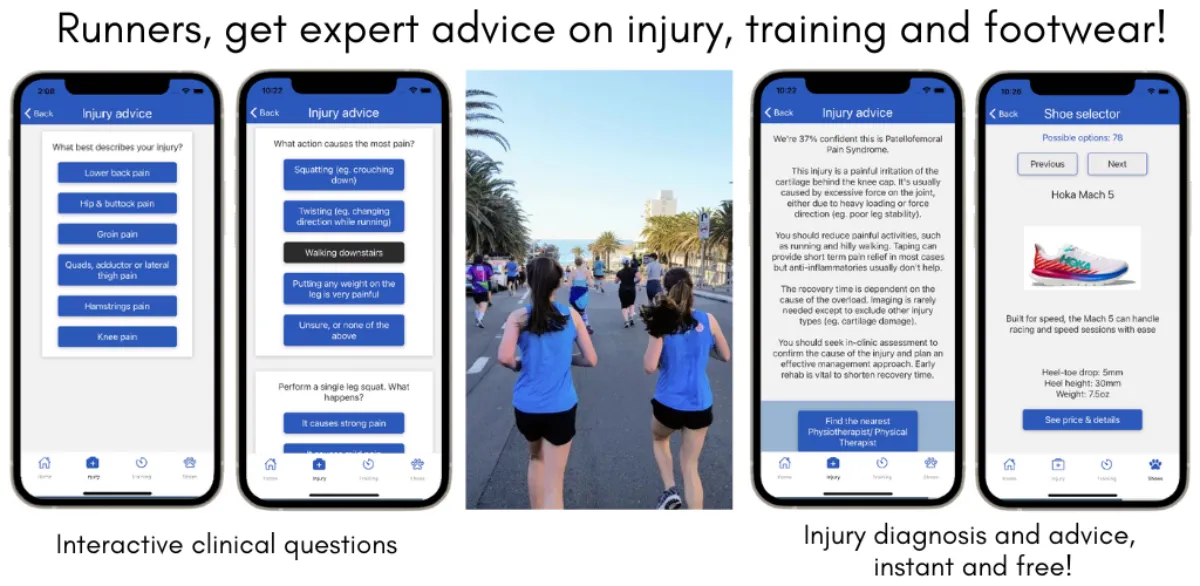In This Article
Ball of foot pain is a common complaint amongst runners, and it can be caused by a number of different factors.
As the pain worsens, it can limit how far you can run, how fast you can run, and it can definitely kill the enjoyment of running.
So what can be done about it?
The most common approach is to change shoes. You need to know what to look for in a shoe to help with the pain (otherwise you’ve just wasted money and added to your frustration) but getting the right shoe can have a immediate impact and make a big difference to ball of foot pain.
You’ll also hear that orthotics, or custom insoles, are an option. But they can be hit and miss and they’re a very expensive option.
The 3rd most common approach is exercises, and while these can be helpful in the long term, they don’t tend to make an immediate difference for ball of foot pain.
Along with ball of foot pain, you might also experience problems like sore/black toenails, very sore hip muscles, ankle pain or blisters on your feet (click on the issue to read more about its causes and fixes).
Those issues may be indicators that the way you’re moving is creating overload on the body and they can also be fixed with the right shoe.
Need expert advice to get the perfect shoe?
We’ve combined the expertise of a Sports Physiotherapist with a running coach to bring you accurate advice, for FREE!
This app, on Android and ios, offers expert advice on the perfect running shoes for you and your niggles.
The app can also diagnose injury and suggest running sessions that won’t flare up any current niggles.

Why do runners get ball of foot pain?
Given the repetition of running and the pressure on the ball of the foot, it’s not surprising that ball of foot pain is quite common (it makes the top 10 most common running pains, along with Achilles pain, hip pain and knee pain).
But that area of the foot is well designed to take that kind of pressure, so there must be something that’s causing it to overload and become painful.
Generally we can divide the causes of pain into 4 main groups:
- Not enough protection from impact
- Too much bend in the joints (compared to the available movement)
- Abnormal direction of force through the joints
- Damage to joints and their protective structures
Not enough protection
When the foot lands on the ground, it typically impacts on the middle or back part of the foot (known as a midfoot or rearfoot strike respectively).
Once you’ve landed, the front of the foot then comes down and hits the ground with some force.
That force then increases as you move to pushing off, as all that propulsion force goes through the front of the foot.
To help spread out the force, a running shoe offers some protection with cushioning to act as padding under the balls of the feet.
If the shoe is too thin (like in racing flats) or the padding has compressed over time, the protection is reduced and the ball of the foot is exposed to more pressure, which often leads to ball of foot pain.
Too much bend
The function of the ball of the foot is to act as a pivot point between the foot and the toes. It means that the toes can stay flat on the ground as the foot lifts off, to help you push off as you run.
If the angle of bend becomes too much compared to how far those joints can move, you’ll get pain.
Some types of running are associated with more bend – sprint starts, very short intervals and hill running are the most common. You can do these as a balanced part of any running program but if they become the dominant part of that program, you’ll begin to get overload.
As we age, you can also lose movement in the ball of the foot. That means it takes less bending to trigger a pain response, so you’ll begin to get ball of foot pain in situations that didn’t previously bother them.
Abnormal forces
This is a funny one, but not haha funny. You can get “abnormal” forces pushed through the ball of the foot if the angle of force is too far away from what the joints can tolerate.
This can happen is the ground is consistently uneven, like running on the camber of the road (camber is the sideways tilt of the road, designed to make the water run off sideways).
You’ll also get abnormal angles if your stability is out, because the foot isn’t in the right position on the ground as you go to push off.
Damage to joints
Lastly we have joint damage or damage to the structures around the joint (like a Plantar Plate tear).
This is often due to prolonged ball of foot pain or to a sudden overload, like tripping and bending your toes backwards.
This category needs assessment from a health professional to determine the best option to manage it, including getting the right running shoes.
If you’ve tried different shoes without success, or if your ball of foot pain came on suddenly after a fall, get it checked out by a professional first.
Physiotherapist recommendations
Here’s a list of the best running shoes for ball of foot pain, matched to each cause of pain above.
- As ball of foot pain is often associated with changes in the width of the forefoot, each shoe option below is available in standard width, wide fit (women’s B or men’s 2E) or extra wide fit (women’s 2E or men’s 4E)
- They also offer different levels of support depending on how much you feel your leg stability and strength is contributing to your ball of foot pain
- Start with shoes from the brands you’ve used before and have found comfortable, as these often match the shape of your foot best.
Best running shoes for ball of foot pain, in a standard or wide fit
Minimal support level
New Balance 990 – a durable, solid shoe with great reviews, it offers good protection under the ball of the foot.
Brooks Ravenna – Brooks are well known for making firmer shoes, which is great for protection of ball of foot pain. Better priced than the NB 990 above.
Moderate support level
Asics Gel GT-2000 – consistently the most popular shoe on the market, the Asics 2000 offers stability, cushioning and protection in one very comfortable package.
Mizuno Wave Inspire – firmer than the Asics 2000s but just as supportive, the Mizuno Inspire has a protective plastic plate under the rearfoot and midfoot to add to its features.
Hoka One One Arahi – Hoka running shoes have become the standout brand for protection with big, thick outsole padding. The Arahi model is also supportive and features Hoka’s rounded forefoot design, to help you roll off your toes rather than pivot through the joints.
Saucony Guide – if you like the shape of Saucony, Adidas or Nike (straighter last), you’ll love the Guide. It has the right mix of protection and performance in a good looking shoe.
New Balance Fresh Foam 860 – if you prefer the shape of Brooks or New Balance, this will fit nicely. It’s light but protective and has great support features.
Brooks Adrenaline GTS – these shoes have undergone a big design change in 2021 with less support but lighter than previous editions. If you’ve always worn Adrenalines, you’ll notice the difference in the new model with a lighter faster shoe.
Maximal support level
Hoka One One Gaviota – the Gaviota gets great reviews, particularly from walkers. Better known for its plush protection than its stability, it’s a great all-rounder for those who need more support.
Asics Gel Kayano – another of Asics classics! It’s been around forever so if you need lots of support, this is probably the one of the best running shoes for support and ball of foot pain.
Best running shoes for ball of foot pain in an extra wide fit
Moderate support level, women’s 2E or men’s 4E width (extra wide)
Asics Gel GT-2000 – one of the most comfortable and versatile shoes that you’ll find for extra wide feet!
New Balance Fresh Foam 860
Brooks Adrenaline GTS – the latest model is lighter but with a little less support than previous iterations.
Maximal support level, women’s 2E or men’s 4E width (extra wide)
Asics Gel Kayano
Disclaimer for Best Running Shoes for Ball of Foot Pain
**Special note: this article has Physiotherapist-recommended products with affiliate links to trusted vendors, selected for their fast & reliable service and great prices. The article was written prior to sourcing the affiliate links and the links in no way influence our recommendations.



